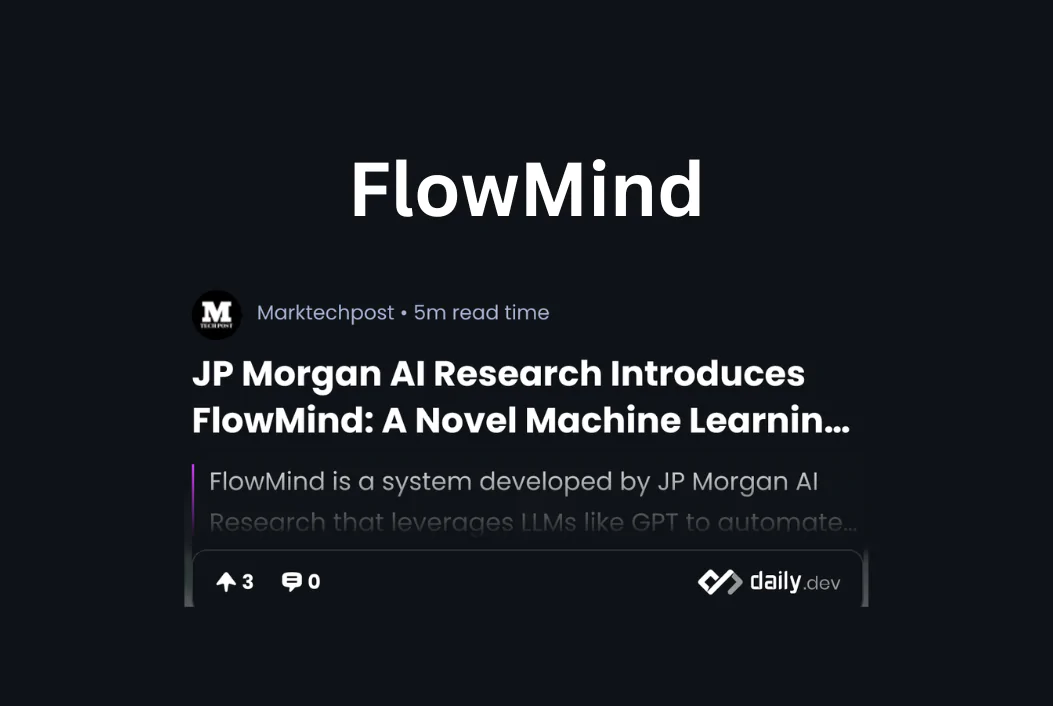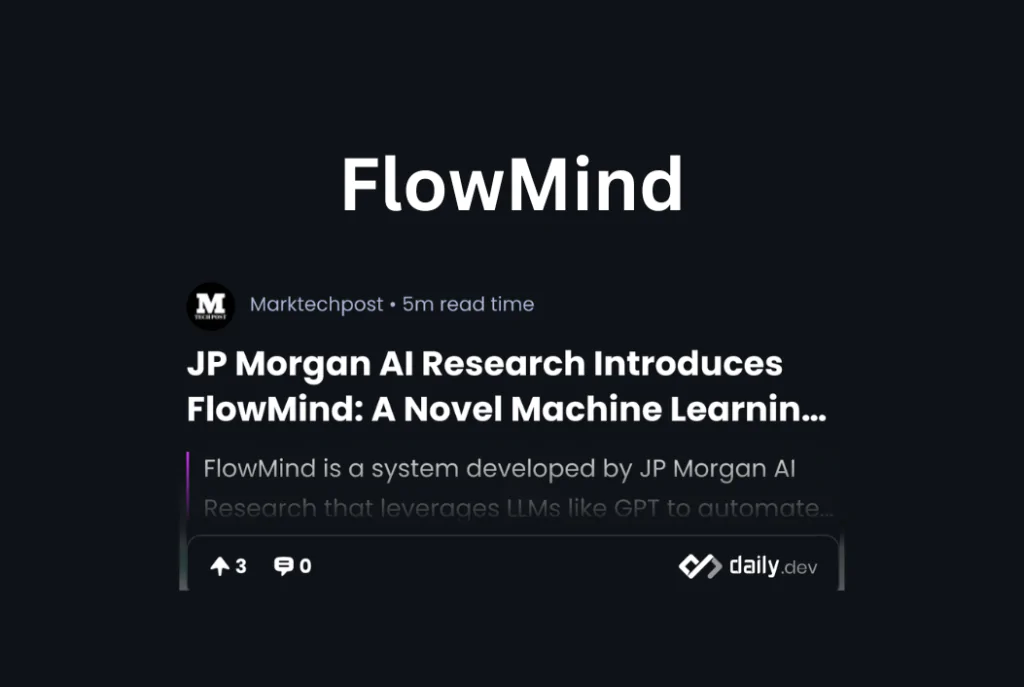FlowMind is a cutting-edge machine learning technique that uses LLMs like GPT to create an automated workflow generation system.
What is FlowMind?
FlowMind is an innovative machine learning approach that harnesses the capabilities of Large Language Models (LLMs) such as GPT (Generative Pre-trained Transformer) to create an automatic workflow generation system. By leveraging the power of natural language understanding and generation, FlowMind revolutionizes the way workflows are created and managed.
Evolution of FlowMind
J.P. Morgan AI Research researchers have unveiled FlowMind, a system that uses LLMs—specifically, Generative Pretrained Transformer (GPT)—to dynamically automate workflows. This innovation is unique in that it uses “lecture recipes” to ensure that LLMs are prepared for task engagement and have a thorough understanding of the API functionality and task context. The model’s capacity to manage challenging, real-world tasks safely and effectively without having to deal with sensitive data directly is greatly increased by this methodology.
How Does FlowMind Work?
FlowMind uses a two-stage, structured framework to function.

Stage 1: Educate LLM
Providing a lecture to the LLM in order to introduce them with the context, available APIs, and the task of creating workflow code is the first step in the FlowMind framework. Three elements make up this lecture’s structured recipe: code, APIs, and context. While the APIs give comprehensive descriptions of the functions that are available, including information on input arguments and output variables, the context introduces the domain of expected tasks or queries. Finally, upon receiving user queries, the LLM is instructed to prepare workflow code using the provided APIs.

Stage 2: Workflow Generation and Execution
The LLM uses the API knowledge it learned in the first stage of the FlowMind framework to handle user queries or tasks in the second stage by creating the necessary workflow code. There are two primary parts to this step: writing code and running it. In order to properly handle the user’s request or task, the LLM builds a workflow utilizing the newly introduced APIs during code generation. The workflow is then executed to yield the intended result.
FlowMind accepts user input at this point. It gives the user a high-level overview of the generated workflow so they can comprehend its structure and functionality without having to dig into the underlying code. This makes it easier for users to provide insightful feedback, which the LLM can use to improve the workflow as necessary and accurately meet the needs of the user.

Key Features
At its core, FlowMind is designed to understand natural language instructions or descriptions provided by users and translate them into actionable workflows. Here are the features:
-
Natural Language Understanding: FlowMind begins by analyzing and interpreting the user’s input, which could be a simple task description or a more complex set of instructions.
-
Workflow Generation: Using sophisticated algorithms and pre-trained models like GPT, FlowMind generates a step-by-step workflow tailored to the user’s needs. This workflow may include task sequences, decision points, and other relevant elements.
-
Adaptability: FlowMind is adaptable to different contexts and domains, allowing it to generate workflows for a wide range of tasks and industries. Whether it’s project management, software development, or customer support, FlowMind can create workflows tailored to specific requirements.
-
Optimization: FlowMind incorporates optimization techniques to enhance the efficiency and effectiveness of generated workflows. By identifying redundancies, optimizing task sequencing, and suggesting improvements, FlowMind helps users streamline their processes and achieve better results.
-
User Interaction: FlowMind encourages user feedback and interaction, allowing users to refine generated workflows, provide additional context, or make modifications as needed. This iterative process ensures that the generated workflows align closely with the user’s intentions and preferences.
Experiments
600 question-answer pairs focused on fund data from N-CEN reports—mandatory annual filings for US registered investment companies—make up the new NCEN-QA dataset. These reports include a wealth of information about different funds, advisors, pricing services, custodians, and financial data. Three levels of difficulty were identified: NCEN-QA-Intermediate, NCEN-QA-Hard, and NCEN-QA-Easy.
- Easy: Questions in NCEN-QA-Easy are centered on individual fund details and are drawn from a sample of 200 funds.
- Intermediate: The questions in NCEN-QA-Intermediate require you to perform mathematical operations on fund data that is also drawn from a sample of 200 funds.
- Hard: NCEN-QA-Hard is a set of 200 sampled questions that focus on multiple funds and require aggregation or investigation across funds.
Results
By comparing output responses to ground truth while taking into consideration entity names and numerical precision, accuracy was determined. FlowMind performed noticeably better than the GPT-Context-Retrieval baseline approach, especially when it came to answering complicated questions.

Benefits of FlowMind
FlowMind offers several key benefits:
-
Time Savings: By automating the workflow generation process, FlowMind saves users valuable time that would otherwise be spent manually creating and managing workflows.
-
Increased Productivity: With FlowMind, users can quickly generate detailed workflows for various tasks and projects, enabling them to focus on execution rather than planning.
-
Consistency and Standardization: FlowMind helps ensure consistency and standardization across workflows, reducing errors and improving overall quality.
-
Scalability: FlowMind is scalable and adaptable to different use cases and organizational needs, making it suitable for individuals, small businesses, and large enterprises alike.
Conclusion
In an era where efficiency and productivity are paramount, FlowMind stands out as a powerful tool for automating workflow generation. By leveraging the capabilities of LLMs like GPT, FlowMind enables users to create detailed workflows with ease, saving time, improving consistency, and driving better results. As businesses and individuals continue to embrace automation, FlowMind represents a glimpse into the future of workflow management.
FAQs
1. What is FlowMind?
FlowMind is an innovative machine learning approach that leverages Large Language Models (LLMs) like GPT to create an automatic workflow generation system. It enables users to describe tasks in natural language and automatically generates detailed workflows to accomplish them.
2. How does FlowMind work?
FlowMind works by analyzing and interpreting natural language instructions provided by users and translating them into actionable workflows. It uses sophisticated algorithms and pre-trained models to generate step-by-step workflows tailored to specific requirements.
3. What are the benefits of using FlowMind?
- Time Savings: FlowMind automates the workflow generation process, saving users valuable time.
- Increased Productivity: Users can quickly generate detailed workflows for various tasks and projects, enabling them to focus on execution.
- Consistency and Standardization: FlowMind helps ensure consistency and standardization across workflows, reducing errors.
- Scalability: FlowMind is scalable and adaptable to different use cases and organizational needs.
4. Is FlowMind adaptable to different domains?
Yes, FlowMind is designed to be adaptable to different contexts and domains. Whether it’s project management, software development, or customer support, FlowMind can generate workflows tailored to specific requirements.
5. Can users provide feedback and make modifications to generated workflows?
Yes, FlowMind encourages user feedback and interaction. Users can refine generated workflows, provide additional context, or make modifications as needed, ensuring that the workflows align closely with their intentions and preferences.
6. How does FlowMind optimize generated workflows?
FlowMind incorporates optimization techniques to enhance the efficiency and effectiveness of generated workflows. It identifies redundancies, optimizes task sequencing, and suggests improvements to streamline processes and achieve better results.
7. Is FlowMind suitable for both individuals and businesses?
Yes, FlowMind is suitable for individuals, small businesses, and large enterprises alike. It offers scalability and adaptability to meet the workflow management needs of users across various industries and organizational sizes.
8. Can FlowMind integrate with existing workflow management systems?
Yes, FlowMind can integrate with existing workflow management systems and tools to enhance automation and streamline processes further.
9. Is there a trial version or demo available for FlowMind?
Yes, users can access a trial version or demo of FlowMind to experience its capabilities firsthand before committing to a full subscription or purchase.
10. How can I get started with FlowMind?
To get started with FlowMind, simply visit our website and sign up for a trial or subscription. Our team will provide you with the necessary resources and support to help you leverage the power of automatic workflow generation with FlowMind.


